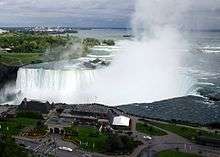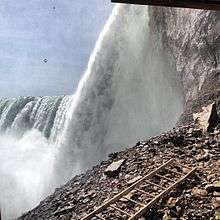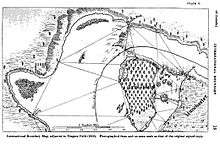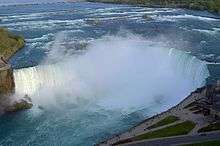Horseshoe Falls





Coordinates: 43°04′38″N 79°04′32″W / 43.077305°N 79.07562°W
The Horseshoe Falls, also known as the Canadian Falls, as most of it lies in Canada, is part of Niagara Falls, on the Niagara River. Approximately 90% of the Niagara River, after diversions for hydropower generation, flows over Horseshoe Falls. The remaining 10% flows over the American Falls. It is located between Terrapin Point on Goat Island in the US state of New York, and Table Rock on the Ontario side of the falls. According to official U.S. Geological Survey maps (see References [7][8] below), approximately two-thirds of Horseshoe Falls is located in Ontario, Canada with the remaining one-third in New York, United States.[2][3][4]
Boundary controversies


When the boundary line was determined in 1819 based on the Treaty of Ghent, the northeastern end of the Horseshoe Falls was in New York, United States, flowing around the Terrapin Rocks, which was once connected to Goat Island by a series of bridges. In 1955 the area between the rocks and Goat Island was filled in, creating Terrapin Point.[5] In the early 1980s the United States Army Corps of Engineers filled in more land and built diversion dams and retaining walls to force the water away from Terrapin Point. Altogether 400 feet (120 m) of the Horseshoe Falls was eliminated. Constant erosion indicates the boundary line will alter into the future.
In October 2007, the Horseshoe Falls was featured in a Disney produced video titled Welcome: Portraits of America, made for the United States Department of State and Department of Homeland Security to promote United States tourism.[6] A controversy surrounded the film, because instead of showing just the American falls and Bridal Veil Falls, they focused on Horseshoe Falls, which lies mostly, though not all, in Canada.
Current (2014) online promotional materials from the Niagara Falls State Park, including the interactive map of the State Park, show the part of the Horseshoe Falls that is in U.S. territory, as determined by U.S. Geological Survey maps. This presentation of only part of Horseshoe Falls reflects a more accurate depiction of the boundaries of Niagara Falls State Park and U.S. territory. These official maps show approximately one-third of the Horseshoe Falls lies within the U.S. (New York State), while approximately two-thirds of the Horseshoe Falls lies on the Canadian side (province of Ontario). Scientists indicate Horseshoe Falls will continue to erode, thus altering future U.S.-Canadian boundaries.[7]
Both the 1995 map cited above and the new 2013 map of the U.S. Geological Survey indicate most of the Horseshoe Falls is in Canada, and both U.S. and New York State boundaries are shown on the newer map.[8]

See also
References
| Wikimedia Commons has media related to Horseshoe Falls. |
- ↑ "Significant Canadian Facts". Natural Resources Canada. April 5, 2004. Retrieved May 23, 2011.
- ↑ Staff report (June 23, 2006). Campaign blunder puts Yankee spin on Canada's national anthem. Regina Leader-Post
- ↑ Lee, Matthew (October 29, 2007). Video claims Horseshoe Falls for U.S. Toronto Star
- ↑ "The international boundary line may pass through the Horseshoe Falls just beyond Terrapin Tower Point, so that the United States are not entitled to as large a portion as Canada of the Horseshoe Falls, which is admittedly not all Canadian." Statement of Mr. J Boardman Scovell. Preservation of Niagara Falls: hearings on the subject of H.R. 26688, Sixty-first Congress, second session, relating to the control and regulation of the waters of Niagara River and the preservation of Niagara Falls, held before the Committee on Rivers and Harbors of the House of Representatives. U.S. G.P.O., 1911
- ↑ Berton, Pierre (2009). Niagara: A History of the Falls. SUNY Press. pp. 20–21. ISBN 978-1-4384-2928-1. Retrieved December 1, 2010.
- ↑ Associated Press; Toronto Star: U.S. annexes Canadian landmark in tourism video; October 28, 2007
- ↑ USGS 1995 Niagara Falls Map
- ↑ USGS Niagara Falls Topo 2013 Map
External links
- Live stream of the Horseshoe Falls Niagara Falls Live Stream
- Horseshoe Falls Artwork